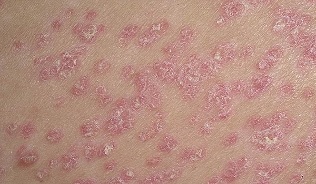Faced with psoriasis, many patients do not recognize immediately the pathology, taking it for allergic skin rashes and some other dermatitis. For the delivery of timely diagnosis of the disease, it is important to know how is the pathology, what are the stage of psoriasis and manifestation of the disease in different stages. The course of psoriasis is characterized by four phases, among which stand out the initial, progressive, fixed the stage and the appeal stage. More details each of the steps look at the article.
The initial phase of psoriasis

Many patients ask as it seems to psoriasis in the initial phase? See the first manifestation of the disease can be in the photo. For this stage in the peculiar development in the skin, characteristic red spots pink with clear boundaries. The disease can occur in different parts of the body. Later granted photo of the pathology in different areas of the body.
The symptoms of psoriasis in the initial phase of
For the initial phase of the disease are characteristic the following symptoms:
- a slight desquamation of the dermis;
- redness of the skin;
- the development of itching;
- feeling of dryness, tightness;
- the formation of spots of different diameters;
- the strengthening gradual peel.
The clinical picture of the pathology may vary depending on the type of disease. Thus, when the psoriasis in drops of the size of the plates has a smaller diameter, not more than 2 to 3 mm. When the most common form, vulgar, precipitation reached a considerable size, of more than 5 cm, often merge among themselves, forming large lakes. For pustular psoriasis tend to education in the dermis crusting yellow or grey tint with the accumulation of serous fluid under them.
The initial phase of the duration of each patient differently. This depends on the type of immunity of the patient and other characteristics of the organism.
The treatment of the initial phase
For the early stages of the disease is more commonly prescribed for the treatment of rashes with the use of ointments, gels, lotions. Medical therapy aims to eliminate itching, flaking, swelling, redness, inflammatory process. For this, apply hormonal and non-hormonal ointments.
Hormonal medication in the initial phase prescribed rarely. Often, their use demonstrates the patients with a current pathology.
Hormonal ointment often cause side effects. Using them is recommended by a doctor.
Progressing stage of psoriasis

Progressing to the stage characterized by the intensification of the manifestation of the disease, plaques becomes increasingly, itching, flaking, edema, inflammation increases. Eruptions on the skin begin to fuse between themselves, hitting us significant tracts of the dermis. In the phase of progress, often appear the symptom as a phenomenon kebnera. The essence of the phenomenon lies in the fact that new eruptions appear in local damage to the skin. If the skin has scratches, abrasions, burns, in its place with large probability to appear on catch. The duration of the stage of progress, on average, lasts about 14 days to several months. In each patient, this time interval depends on the individual characteristics of the body and the speed with which the immunity to deal with the pathology.
The treatment of the phase phase -
Sharp during the psoriasis requires an integrated approach using the following methods:
- The medication treatment.
- The use of physiotherapy.
- Correction of the life style of the patient.
Important! The tactic of treatment is adjusted individually for each patient depends on the severity of the disease, their flow characteristics and presence of complications.
Doctor medicines
To get rid of plaque and reduce the symptoms of the disease in medical practice use the following groups of drugs:
- Anti-histamines – calculated on the reduction of such manifestations, such as itching, redness.
- Sedative medications allow you to remove the excess nervous tension, to normalize the sleep.
- Anti-inflammatory drugs safely relieve the inflammatory process, helps to eliminate redness and other signs of disease.
- Diuretics, medicines, calculated on the excretion from the body excess liquid and salt. These medicines help to clear the body, which positively affects the course of the disease.
- Keratolytic – contribute to a good exfoliation of the epidermis, make the regeneration of the dermis, of your update.
- Immunomodulators – governing the immunity of a person, which is an important condition for recovery.
- Hormonal ointment give quick result, apply, predominantly, in severe disease.
- ) – Have the property of inhibiting the immune system, which sometimes is needed to get rid of psoriatic plaques.
All the medications should be used only after the appointment of a doctor. Self-medication will only get worse during pathology.
Physical therapy treatment
The methods of physical therapy include:
- PUVA-therapy;
- The use of ultra-sound radiation.
- Magnetic therapy.
- Selective therapy.
- The laser beams.
- Mud therapy.
- Wax appliques.
- Sanatorium treatment.
The number of sessions and the length of the handle the doctor, considering the characteristics and type of disease, as well as information quality and general well-being of the patient.
Folk methods

From tales of methods the recommended therapeutic:
- The natural oils (juniper or lavender). Have a healing and calming effect, beneficial to the state of the skin. Method of application: a few drops of oil add to the cream cause the precipitation.
- The hydrogen peroxide (3%). Is applied to a point and not washed. Before applying you should consult your dermatologist.
- 30 g of propolis and mix with 250 ml of vegetable oil (oil pre-boil). The cooked mixture must be applied to dissolve the keratinized layer of the epidermis and restore the elasticity of the skin.
- Beeswax. This product has an anti-inflammatory and softens the effect. Bee wax needs to melt the water bath, then carefully applied on the shell, covering the papules.
- Honey. The main product, the process of the bees has a positive effect on the human body when psoriasis. It needs to be consumed in small quantities – 2 tablespoons per day.
Dye against psoriasis
From the people treatment methods are used the same oil and hydrogen peroxide.
It is possible to add a dye based on celandine. For your kitchen you will need 3 tablespoons of plants (dry or fresh) and salt water. In any case, it is possible to use the alcohol, as this can retain moisture of the skin.
How to prepare the remedy:
- the components should mix with each other;
- leave for a few hours.
Before you apply the dye to the skin is recommended to anoint the birch tar (dot), to enhance the medicinal effect.
Therapy was most effective, the patient should go to the diet, harmful products lead to the worsening of the state.
The diet when psoriasis

Patients with psoriasis, it is important to respect the correct power supply. Following a diet that more rapidly clear the skin of boards, it will prevent the complication of the disease.
Principles of nutrition therapy for the following:
- The need to abandon the spicy, salty, acidic, fried foods. Such products will only reinforce the growth of the plates.
- The diet should be saturated with plenty of vegetables, fruits.
- In the role of main dish to choose best cereals, soups, lean varieties of fish and meat.
- In the work, they should not be present in product allergens. You need to give up eggs, nuts, chocolate, citrus fruits.
- Drinks with caffeine are also deleted.
- Denied the alcohol, soft drinks.
- Dairy products should not contain fat. Preference should be given yogurt without additives, kefir, milk.
Eating is recommended in small portions, avoiding eating in excess. Diet is important that are the therapy of the disease. The appropriate food helps to satiate the body with vitamins, rid of impurities and toxins.
Fixed phase
The fixed phase is characterized by a decline in the growth of psoriatic plaques, however, its amount in the body is not reduced, the disease is as if it enters sleep mode. If you have provoking factors of pathology of the fixed can go again in a phase of progress. The causes of this phenomenon becomes improper treatment, refusal to diet, skin lesions. The duration of the phase so different in different patients, which is very difficult to even take on its border. On average, it is the time that it takes from a few weeks up to several years.
The phase of regression
The phase of regression is the last step before remission of the disease. Here are indicated the following changes:
- Color papules red comes in a pale pink hue.
- Decreases the amount of bark.
- Out itching.
- The skin is clean, it acquires a tone smooth and structure.
- When you do this, in different areas of the body remain the so-called "remnants of platelets". Such eruptions not fully pass through and are stored in the skin, even in period of remission.
Psoriasis refers to a chronic disease dermatitis, non-communicable nature. To completely get rid of the pathology, which today is not possible. The patients with the pathology, it is necessary to a whole life-stick prevention activities, aimed at the prevention of relapse. Many patients are able to maintain the period of remission for the next few years, to lead a complete life style.























